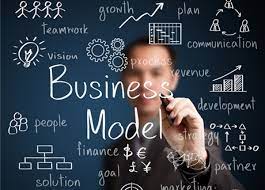A business model is a representation of how a business creates and delivers value for a customer while also capturing value for itself, doing so in a repeatable way.
According to the Lean Startup Methodology: A startup is a human institution designed to create a product or service under conditions of extreme uncertainty. A Lean Startup is a temporary organization designed to search for a repeatable and scalable business model. It is a methodology for developing businesses and products that aims to shorten product development cycles and rapidly discover if a proposed business model is viable. 1
A Lean Startup is a temporary organization designed to search for a repeatable and scalable business model

In the early 2000s, there was a proliferation of internet-based companies without a clear strategy for making money and retaining customers. Their business model was not well articulated , hence they confused revenue for profit. As the saying goes “Turnover is vanity, profit is sanity and cash is reality.” The speculation led by these internet companies was one of the major cause of the Internet bubble.
“Business model” is one of those terms of art that were central to the Internet boom; it glorified all manner of half-baked plans. All it really meant was how you planned to make money. The “business model” for Microsoft, for instance, was to sell software for 120 bucks a pop that cost fifty cents to manufacture. The “business model” for Healtheon was to add a few pennies to every bill or order or request that emanated from a doctor’s office. The “busi- ness model” for Netscape was a work in progress; no one really ever did figure out how to make money from Netscape; in its brief life Netscape had lost money. The “business model” of most Internet companies was to attract huge crowds of people to a Website, and then sell others the chance to advertise products to the crowds. It was still not clear that the model made sense. —Michael Lewis, The New New Thing: A Silicon Valley Story
The internet bubble had lots of casualties such as Webvan.com, pets.com, boo.com among others and some survivors such as Amazon, eBay, Cisco and Priceline.
The purpose of a business: to create a customer. - Peter Drucker
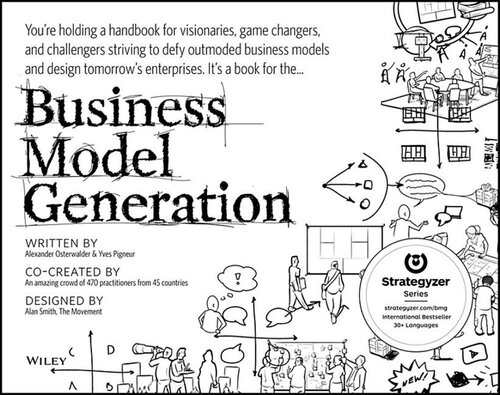
A business model describes the rationale of how an organization creates, delivers, and captures value.
A business model describes the rationale of how an organization creates, delivers, and captures value. In their book, Business Model Generation: A Handbook for Visionaries, Game Changers, and Challengers, 2 Swiss Entrepreneur Alexander Osterwalder and Belgian computer science professor Yves Pigneur describe the nine blocks for building a business model: customer segments, value propositions, channels, customer relationships, revenue streams, key resources, key activities, key partnerships, and cost structure.
They write:
A business model can best be described through nine basic building blocks that show the logic of how a company intends to make money. The nine blocks cover the four main areas of a business: customers, offer, infrastructure, and financial viability. The business model is like a blueprint for a strategy to be implemented through organizational structures, processes, and systems. 3
The Nine Building Blocks of a Business Model
- Customer Segments
Customer Segments defines the different groups of people or organizations an enterprise aims to reach and serve
2. Value Propositions
The value proposition describes the bundle of products and services that create value for a specific Customer Segment. The Value Proposition is the reason why customers turn to one company over another.
3. Channels
The Channels describes how a company communicates with and reaches its Customer Segments to deliver a Value Proposition.
4. Customer Relationships
Customer relationships describes the types of relationships a company establishes with specific Customer Segments.
5. Revenue Streams
The Revenue stream represents the cash a company generates from each Customer Segment (costs must be subtracted from revenues to create earnings).
6. Key Resources
Key resources describes the most important assets required to make a business model work.
7. Key Activities
The Key activities describes the most important things a company must do to make its business model work.
8. Key Partnerships
The Key partnerships describes the network of suppliers and partners that make the business model work.
9. Cost Structure
The Cost Structure describes all costs incurred to operate a business model.
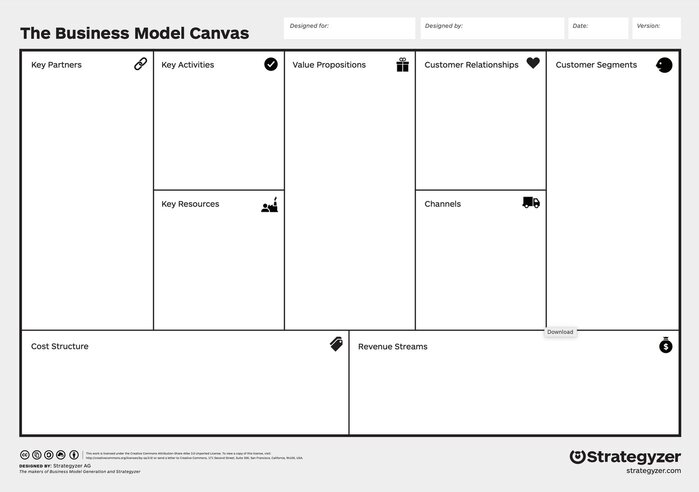
Management Consultant and author of What Management Is: How It Works, and Why It’s Everyone’s Business,Joan Magretta defines a business model as a set of assumptions about how an organization will perform by creating value for all the players on whom it depends, not just its customers. In essence, a business model is a theory that’s continually being tested in the marketplace.
Business models 3 are, at heart, stories that explain how enterprises work. Like a good story, a robust business model contains precisely delineated characters, plausible motivations, and a plot that turns on an insight about value. It answers certain questions: Who is the customer? How do we make money? What underlying economic logic explains how we can deliver value to customers at an appropriate cost
“A business model isn’t a strategy, even though many people use the terms interchangeably. Business models describe, as a system, how the pieces of a business fit together. But they don’t factor in one critical dimension of performance: competition. That’s the job of strategy.”
A great business model is a storytelling framework that seeks to answer the questions: Who is our customer? and How are we going to deliver value to the customers? Most business models are a variation of the existing business value chain delivery method of other businesses.
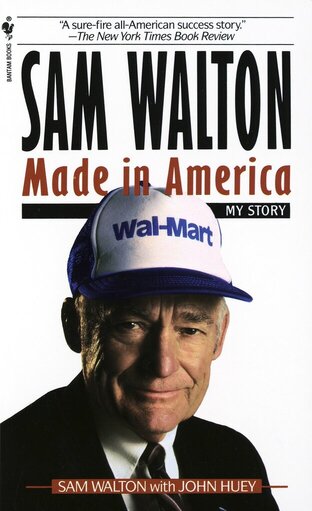
A great example of Business Model Innovation is Sam Waltons’ disruption of the discount stores industry in the early 60s. Walton borrowed most of his ideas from discount stores such as Kmart and Sears to create Walmart. With a mission of “saving people money, so they can live better”, he built the world’s largest retailer by studying other discount stores’ business models but what made Walmart different was the execution and strategy implementation of the plan. As Walton noted in his autobiography, Made in America: 4
There’s nothing at all profound about any of our principles. In fact, they’re all common sense, and most of them can be found in any number of books or articles on management theory—many of which I’ve read and studied over the years. But I think the way we’ve applied them at Wal-Mart has been just a little different.
“In those days, Kmart wasn’t going to towns below 50,000, and even Gibson’s wouldn’t go to towns much smaller than 10,000 or 12,000. We knew our formula was working even in towns smaller than 5,000 people, and there were plenty of those towns out there for us to expand into. When people want to simplify the Wal-Mart story, that’s usually how they sum up the secret of our success: “Oh, they went into small towns when nobody else would.” And a long time ago, when we were first being noticed, a lot of folks in the industry wrote us off as a bunch of country hicks who had stumbled onto this idea by a big accident.”
“Maybe it was an accident, but that strategy wouldn’t have worked at all if we hadn’t come up with a method for implementing it. That method was to saturate a market area by spreading out, then filling in. In the early growth years of discounting, a lot of national companies with distribution systems already in place—Kmart, for example—were growing by sticking stores all over the country. Obviously, we couldn’t support anything like that.”
According to the Fortune Global 500 list: Walmart is today the world’s largest company by revenue, with annual revenue of $559 billion and is also the largest private employer in the world with 2.3 million employees.
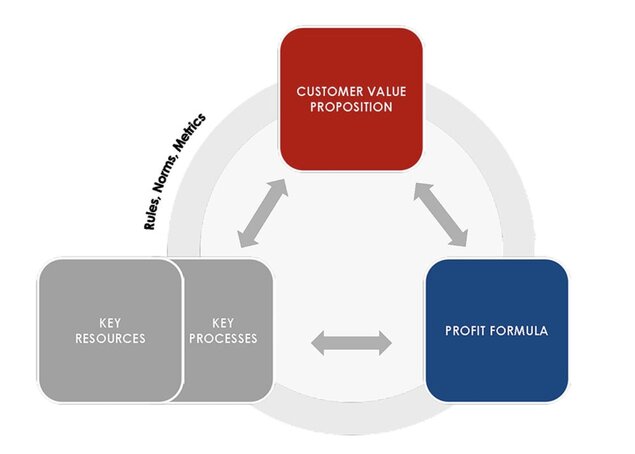
The Elements of a Business Model 5
A Business Model consists of four interlocking elements that, taken together, create and deliver value.
Customer value proposition (CVP)
A successful company is one that has found a way to create value for customers—that is, a way to help customers get an important job done. The job is a fundamental problem in a given situation that needs a solution.
The CVP describes how a company creates value for a given set of customers at a given price.
Profit Formula
The profit formula defines how the company will capture value for itself and its shareholders in the form of profit. It does this by distilling an often-complex set of financial calculations into the four variables most critical to profit generation: revenue model, cost structure, target unit margin, and resource velocity.
Key Resources
The people, technology, facilities, equipment, funding, branding, and raw materials required to create the product or service and deliver it.
Key Processes
People in organizations develop to produce and deliver products in repeatable, scalable, and sustainable ways.
The customer rarely buys what the company thinks it is selling him. – Peter Drucker
Having a clearly defined business model is the first step in dominating an industry but having a strategy to execute the plan is what would differentiate you from your competitors.
Join our 12-week cohort of tech startups for Black founders by Black industry experts to learn the strategies for implementing your business model.
